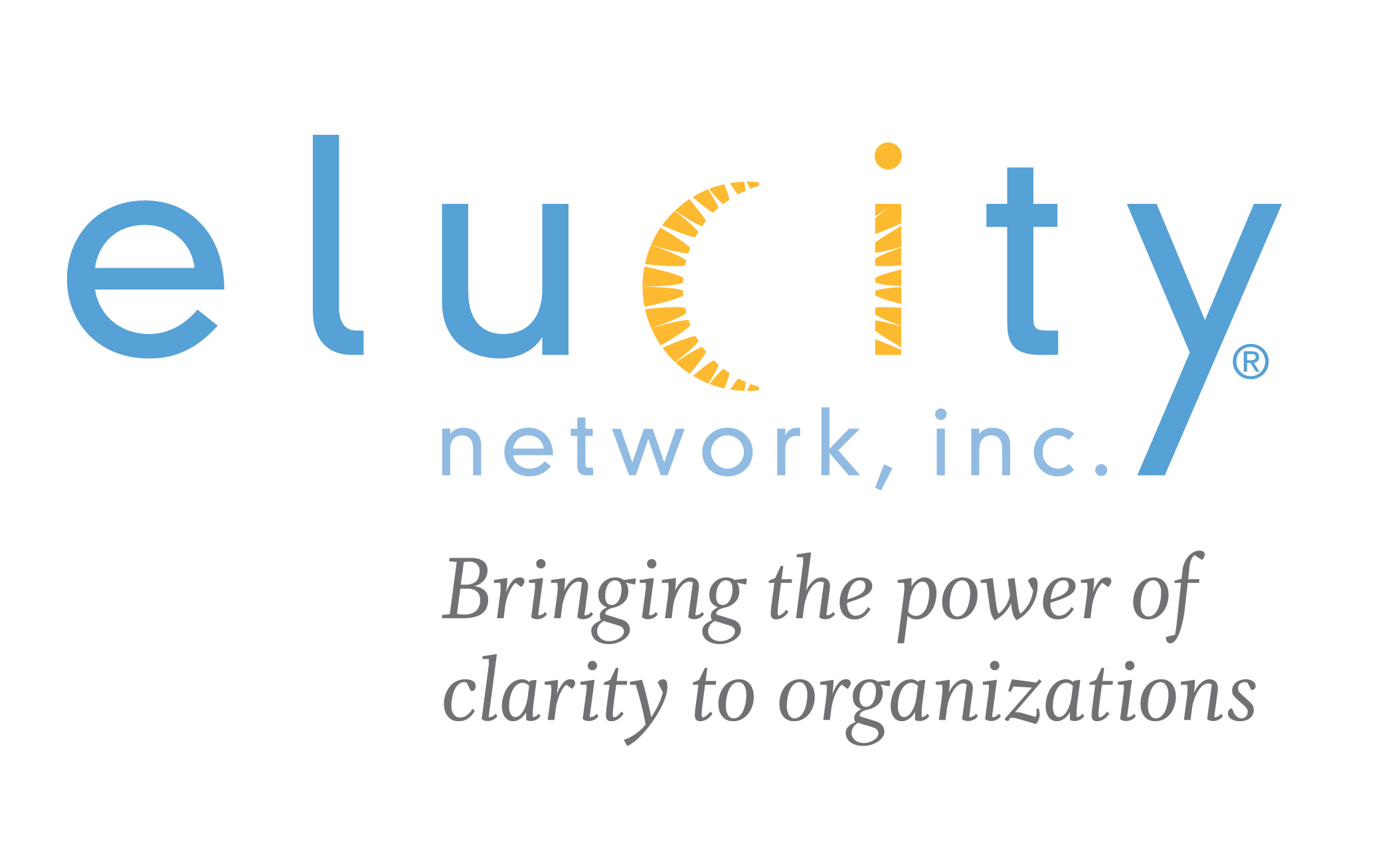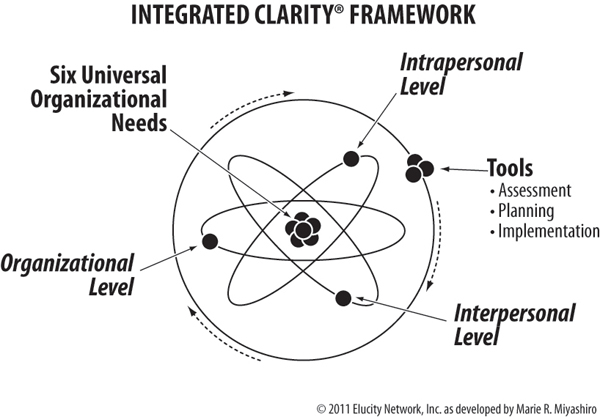Elucity: Who We Are
 Elucity Network, Inc., supports organizations and communities to do their best thinking together. A team of master facilitators, consultants and trainers design conversation processes for both multi-stakeholder and single stakeholder groups that are focused on everything from problem solving and developing their preferred “Bright Future” together to conflict resolution and innovation development.
Elucity Network, Inc., supports organizations and communities to do their best thinking together. A team of master facilitators, consultants and trainers design conversation processes for both multi-stakeholder and single stakeholder groups that are focused on everything from problem solving and developing their preferred “Bright Future” together to conflict resolution and innovation development.
A Connect-Think-Do model of collaboration, communication and change has helped hundreds of client teams in business, universities, government agencies and nonprofits reach the higher ground of shared purpose and mutual respect with uncommonly high satisfaction ratings and long-term positive results.
Elucity President and Chief Facilitation Officer, Marie Miyashiro, has been guiding organizations and leaders for decades. The field-tested approach she developed, Integrated Clarity®, transforms workplaces bottom up to top down. Participants make the leap from mistrust, missed opportunities and power plays to higher ground–a place bringing out the best in people and their best thinking together–where new directions and insights bring results: smoother productivity, smarter success, increased innovation and a higher calling at work. She designs and facilitates unexpectedly transformative and enjoyable conversations that matter.
Her book, The Empathy Factor – Your Competitive Advantage for Personal, Team, and Business Success, was published by PuddleDancer Press in 2011. The foreword is by Jerry Colonna, a top financier for the new economy. Endorsements for it come from business leaders, including Jim Hayes, former Publisher of FORTUNE magazine, academic deans and faculty, and nonprofit leaders. Integrated Clarity® is featured in The Change Handbook – The Definitive Resource on Today’s Best Methods for Engaging Whole Systems and the chapter is co-authored with Marshall Rosenberg, Ph.D., of the Compassionate Communication process. She has more than two dozen partnering and communications awards working with Fortune 500 clients, nonprofits, unions, universities and government agencies.
“Marie Miyashiro facilitates with style and sensitivity. Our VCU arts leadership retreat reached new levels of results through engaging conversation and visual formats. This leapfrogged us into action steps that continue today. Their good spirit provided us with a congenial atmosphere prompting honest discussion, a clear view of our challenges and a road map to pursue even greater opportunities.”
~ Joe Seipel, Dean – School of the Arts, Virginia Commonwealth University
“Best and most efficient strategic planning session I have experienced in 37 years in business.”
~ Gordon Amini, Head Legal Counsel, Physicians Liability Insurance Company
“This was truly a fantastic collaborative brainstorming session that I believe will lead to the increase and preservation of affordable housing.”
~ Susan Soto, City of Tucson, Tucson Metropolitan Housing Commission Member
“A most amazing process… Elucity has shown light into the corners of the most dark areas of challenge in our organization. Marie and her team did the unimaginable by gifting our team with heart and the ability to be honest.”
~ Dylan Ross, Therapist/Counselor, Kaiser Permanente San Francisco
“I recommend this workshop to teams that are having difficulty prioritizing their tasks. I feel that we truly have a vision for the year! Completely and utterly excited!!!”
~ Carol Corcoran, Client Manager, Merck, SBS Americas Support Services
“Came in the first morning feeling very skeptical about the two day session and left feeling incredibly empowered.”
~ Carl Sagar, Business Unit Support Specialist, Merck, SBS Americas Support Services
“Integrated Clarity is a gateway into a Life-Affirming way of thinking and behaving….incredibly inspiring and empowering.”
~ Anita Nowak, Organizational Trainer/Consultant, Montreal, Canada
“What an invaluable methodology for creating consensus! Thanks so much!”
~ Diane McCloskey, Associate Professor, Kent State University School of Music
“Marie is a master facilitator in creating an environment where groups move forward on their critical needs and goals to achieve more results. Whether there’s conflict or collaboration, it’s transformative.”
~ Raymond Tymas-Jones, Associate Vice President for the Arts and Dean, College of Fine Arts, The University of Utah; Past President International Council of Fine Arts Deans
“Marie and the entire IC Globally Team provide engaging, insightful and thoughtful facilitation and guidance. As a direct result of our work with them, the College is implementing a strategic plan that is clear, action-oriented and forward thinking. Everyone is invested in transforming our College into the best it can be.”
~ Dr. John R. Crawford, Dean, College of the Arts, Kent State University; President-Elect International Council of Fine Arts Deans

Why We Exist
Elucity is passionate about workplaces that embrace and capitalize on the human element instead of tolerating, dismissing or “managing” it for us—profit, morale and technology make up the three-legged stool.
We do this in two ways; first, we work with clients from a wide array of geographic areas and industries with the services we offer. We’re here to help our clients discover and explore how to increase productivity and profit in balance with people needs. Second, we serve as an information and training resource and support system for consultants, coaches and facilitators/trainers who want to practice the Integrated Clarity®, Nonviolent Communication and other needs-based participative approaches to workplace consulting and training.
Individually and collectively, the firm has built careers around finding more ways to make profit and organizational sustainability an enriching human effort as well. That’s why we’re here.
Where We Are Going
Elucity is looking for clients and consultants, facilitators and trainers who want to collaborate with us in our quest for workplace and organizational results by capitalizing on and celebrating the human elements rather than tolerating, “managing” or ignoring them.
We want to profit with our clients, employees, partners and collaborators rather than from them. Our framework engenders self-reflection and conscious personal growth. We think profit is something that happens inside of us, as well as in the bottom line.
The firm believes in “natural growth”— that our success will come as a by-product of serving universal human and organizational needs in the clients and collaborators we serve.
Clients
Our Elucity client list includes: National Telecommunications Companies; State and Private Universities and Colleges; Fortune 500 to Small Businesses; International and Local Nonprofits; State and Federal Government Agencies; Healthcare Facilities and Associations; State and National Education Associations; International and State Industry Associations.
Case Study
Case Study: International Industry Association
Adapted from the case study in The Empathy Factor – Your Competitive Advantage for Personal, Team, and Business Success, pages 124-127
In the 1990s and continuing into 2005, an international industry association experienced stagnation of growth in membership. Its members were also experiencing high turnover in their institutions. The president of the association, for the first time, included task committee chairs in a board of directors’ retreat, inviting the group to clarify its vision and mission in a newly participative way that focused on organizational needs.
Since 2005, Elucity had worked periodically with this group and its new president in 2010 to define and meet their six organizational needs. The Integrated Clarity ® (IC) process is built on an adaptable whole-system change framework that integrates the work of Jim Collins, Kimball Fisher, William Bridges, and current organizational thinking from other leaders in the field.
The IC process involves a series of strategic conversations, the results of which are implemented over a timeframe that averages about four years. The strategies are first developed in a series of discussions; they are then implemented and tested; and finally, they’re refined over time. This group began with a discussion of Identity and Life-Affirming Purpose and later addressed Direction. Their clarity about Structure, Energy, and Expression needs grew organically out of these conversations, as elements of Elucity’s IC model were determined.
The strategic process began with the executive planning team participating in the 10 Minutes to Clarity Organizational Needs Assessment, an online assessment tool that measures sixteen individual and organizational qualities known to contribute to higher levels of productivity and profit. The assessment revealed the levels at which both organizational needs and people needs were being met and helped to focus our strategic conversations for increased impact, efficiency, and meaning. Results showed that the association was meeting people needs such as Respect, Trust, Acknowledgment, Meaning, and Learning. Organizational needs such as Direction, Structure, and Energy were not as strongly met. This demonstrated that the group had made progress with two of its key components, Identity and Life-Affirming Purpose, since our first strategic conversation about these needs. Group members were now ready to determine strategies and turn those strategies into action in a unified Direction with Structure and Energy and means of Expression behind it. After discussing the association’s Identity and using the Gradients of Agreement tool for decision-making, the group arrived at a unified statement of Identity. From this, the association’s Expression would organically grow. The leaders then determined their statement of Life-Affirming Purpose. This single purpose upon which the group exists and every decision is based changed the structure and manner in which it operates to do what it’s Best at: “Providing forums and services to meet the professional development and networking needs of their members and their administrative teams.”
The group’s Passion of “Coming together in the spirit of collegiality and camaraderie to share, renew, inspire, and collaborate in service of advancing their industry,” took two-and-a-half days to determine. The robust, highly dynamic, and highly sophisticated dialogue was intended to bring out the wisdom of each person, which collectively creates a result greater than any one person could come to on his or her own.
The insight of “coming together”(as a crystallization of their Life-Affirming Purpose) sounds simple; but up to that time, they were modeling themselves on fairly traditional organizations, and that was about to change.
They immediately applied their new insights to the annual conference coming up in a few months. Intention drove the structure of the conference rather than the other way around. For example, instead of focusing on a structure such as five sessions of seventy-five minutes each, they asked, “What format would be most conducive to ‘coming together’?” They found that the most exciting part of the conference wasn’t the sessions but getting together in between sessions and for lunch or for social connections after formal sessions. Hence, they conducted more casual professional development by having a speaker over lunch, for example. They flip-flopped their conference schedule, and as a result, they received the most positive feedback they’d ever had on the post-conference survey. The conference appeared more like their unifying statement in action and conference participants found value and power in coming together to enhance their collective identity, exchange ideas, and provide practical problem solving.
The association used “coming together” as the litmus test to keep, develop, or stop its various programs or activities. For example, the group eliminated the telephone mentoring program because of its one-on-one structure. This mentoring didn’t have the camaraderie of “coming together” that the whole group had—which was confirmed by the fact that people hadn’t shown as much interest in this program as other events that had the “coming together” component. The group began to track “coming together” time as a quantifiable measurement.
The group had its highest annual conference attendance ever that year. Within two years of determining its purpose and changing the structure and manner in which it operated, membership increased by 27 percent and continued to grow through 2010. The group dramatically improved its ability to serve its members. Numerous strategic opportunities are now being determined for future services, conferences, and benefits for its members.
The leaders became clear on how the board, committees, staff, and members could work together and how the organization could become a mechanism for members to provide input into national policy issues. They also determined how to describe this Structure and its implementation at the Fall 2010 conference and in so doing, engaged more leaders in the effort to elevate their strategic goals.